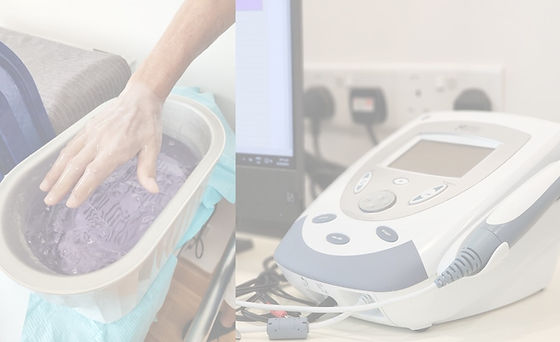
Contrast Bath
A contrast bath, also known as a hot-cold immersion therapy or a hot-cold hydrotherapy, is a therapeutic technique that involves alternating between hot and cold water or other substances to stimulate circulation, reduce muscle soreness, and relieve pain. This contrast of temperatures can help improve blood flow, reduce inflammation, and promote healing. Here's a home instruction on how to perform it:
Procedure:
-
Start by immersing the affected body part (e.g., hands, feet, or legs) in hot water for a specified duration. The water temperature for the hot bath should be comfortably warm but not hot enough to burn the skin, typically around 37-43°C.
-
After the hot bath, transfer the body part directly to the cold water basin, which should contain cold water at a temperature of around 10-15°C.
-
The duration of time in the cold water should be shorter than in the hot water, typically 1/3 the duration in hot water.
-
The process is repeated, typically for 3 to 4 cycles, starting and ending with the hot bath. Each cycle may last around 2-5 minutes in hot water and 1-2 minutes in cold water.
Benefits of Contrast Baths:
-
1Enhanced Circulation: Alternating between hot and cold water causes blood vessels to expand (vasodilation) during the hot phase and contract (vasoconstriction) during the cold phase. This contrast stimulates circulation, improving blood flow to the treated area.
-
Reduction of Muscle Soreness: Contrast baths are commonly used to relieve muscle soreness, such as in athletes following intense physical activity.
-
Pain Relief: The hot-cold contrast can provide pain relief for certain conditions, including arthritis and joint pain.
-
Reduced Swelling and Inflammation: The alternating temperatures can help reduce swelling and inflammation in the treated area.
Precautions:
-
Be cautious not to use extremely hot or cold temperatures to avoid burns or frostbite.
-
Always monitor your comfort level and skin response during the treatment. If you experience discomfort, numbness, or skin color changes, discontinue the contrast bath.
-
Individuals with certain medical conditions, such as poor circulation or neuropathy, should consult with our therapists at CARe before attempting contrast baths.
-
4.If you have specific medical concerns or doubts about using contrast baths, it's advisable to seek guidance from our therapists at CARe
Evidence:
Staton et al. (2009) provided a comprehensive review which consolidates the current evidence on the impact of contrast baths, revealing limited support for the assertion that contrast baths influence superficial blood flow and skin temperature outcomes. The constraints within the existing studies hindered the formulation of more conclusive findings.
Contrast baths may be a useful self-care technique, particularly for minor aches, muscle soreness, or to promote circulation. However, it's essential to use them safely and effectively, and if you have a specific medical condition or injury, it's best to consult with our Physiotherapists and Occupational Therapists at CARe before using this therapy.
References:
-
Hartzell, T.L., Rubinstein, R., Herman, M. (2012) Therapeutic Modalities - An updated review for the hand surgeons. Journal of Hand Surgery. 37A: 597-621.
-
Staton D.E.B., Lazaro, R., Macdermid, J.C. (2009). A systematic review of the effectiveness of contrast baths. Journal of Hand Therapy. 22(1): 57-69.

